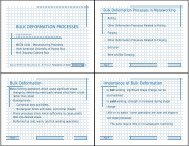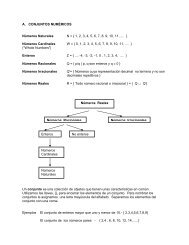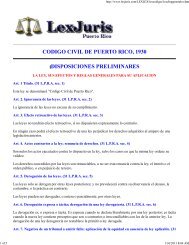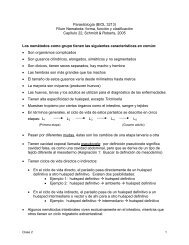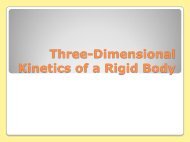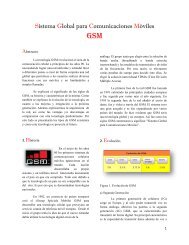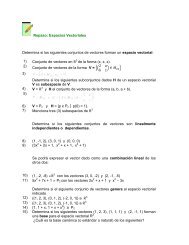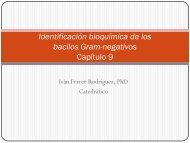Accounting
Accounting
Accounting
You also want an ePaper? Increase the reach of your titles
YUMPU automatically turns print PDFs into web optimized ePapers that Google loves.
Chapter 4<br />
ACCRUAL<br />
ACCOUNTING<br />
CONCEPTS<br />
2
Chapter 4<br />
Accrual <strong>Accounting</strong> Concepts<br />
• Explain the revenue recognition principle and the<br />
matching principle.<br />
• Differentiate between the cash basis and the<br />
accrual basis of accounting.<br />
• Explain why adjusting entries are needed and<br />
identify the major types of adjusting entries.<br />
• Prepare adjusting entries for prepayments.<br />
3
Chapter 4<br />
Accrual <strong>Accounting</strong> Concepts<br />
Prepare adjusting entries for accruals.<br />
• Describe the nature and purpose of the adjusted<br />
trial balance.<br />
• Explain the purpose of closing entries.<br />
• Describe the required steps in the accounting cycle.<br />
4
11<br />
Time Period Assumption...<br />
Divides the economic life of a<br />
business into artificial time<br />
periods<br />
WHY<br />
to provide immediate<br />
feedback on how the<br />
business is doing.<br />
5
Time Period Assumption...<br />
Generally a month, a quarter, or a year.<br />
An accounting time period that is one year<br />
long is called a fiscal year.<br />
An accounting time period that starts on January 1 and<br />
ends December 31 is called a calendar year.<br />
6
Revenue Recognition Principle...<br />
• Dictates that revenue be recognized in<br />
the accounting period in which it is<br />
earned.<br />
• Is considered earned<br />
• when the service has been provided or<br />
• when the goods are delivered.<br />
7
Matching Principle...<br />
Requires that expenses be<br />
recorded in the same period in<br />
which the revenues they helped<br />
produce are recorded.<br />
8
Review<br />
Which principle dictates that efforts (expenses)<br />
be recorded with accomplishments (revenues)<br />
a. Cost Principle.<br />
b.Matching Principle<br />
c. Periodicity Principle<br />
d.Revenue Recognition Principle<br />
10
Review<br />
Which principle dictates that efforts (expenses)<br />
be recorded with accomplishments (revenues)<br />
a. Cost Principle.<br />
b.Matching Principle<br />
c. Periodicity Principle<br />
d.Revenue Recognition Principle<br />
11
Review<br />
When would revenue be recorded for the<br />
following scenario . . .<br />
Ad agency is hired for a project in May,<br />
does the work in June and is paid in<br />
July<br />
June<br />
12
Review<br />
When would expenses be recorded for this<br />
companion scenario <br />
The Ad agency on this project incurs<br />
$1,500 of expenses in May, $3,000 in June,<br />
and none in July<br />
The answer is June! Matching<br />
says the expenses should follow<br />
the revenue.<br />
13
Review<br />
When would revenue be recorded for the<br />
following scenario . . .<br />
Sell plane ticket on September 1 for a<br />
flight on October 15<br />
The answer is October – when the<br />
service is provided!<br />
14
Review<br />
When would expenses be recorded for the<br />
following scenario . . .<br />
The airline pays pilot salaries on October 7 th<br />
for the week ended September 30th<br />
The answer is September – the pilots<br />
provided labor services for September<br />
flights during that month.<br />
15
211<br />
Cash Basis<br />
Revenue recorded only when cash is received.<br />
Expense recorded only when cash is paid.<br />
16
Accrual Basis <strong>Accounting</strong><br />
Adheres to the:<br />
• Revenue Recognition Principle<br />
Revenue recorded only when<br />
earned, not when cash is<br />
received<br />
• Matching Principle<br />
Expense recorded only when<br />
incurred, not when cash paid<br />
17
Accrual Basis adheres to...<br />
•Generally<br />
•Accepted<br />
•<strong>Accounting</strong><br />
•Principles<br />
18
Types of Adjusting Entries<br />
• Prepayments:<br />
• Prepaid expenses: Expenses paid in cash and recorded<br />
as assets before they are used or consumed.<br />
• Unearned Revenues: Cash received and recorded as<br />
liabilities before revenue is earned.<br />
• Accruals:<br />
• Accrued revenues: Revenues earned but not yet<br />
received in cash or recorded.<br />
• Accrued expenses: Expenses incurred but not yet paid<br />
in cash or recorded.<br />
20
Prepayments<br />
•PREPAID EXPENSES - Costs that<br />
expire either with the passage of time<br />
or through use.<br />
•UNEARNED REVENUES- money has<br />
been received before the goods or<br />
services are provided.<br />
21
You can start with the trial<br />
balance to find information to<br />
adjust prepayments.<br />
22
Sierra Corporation<br />
Trial Balance<br />
October 31, 2007<br />
Debit Credit<br />
Cash $15,200<br />
Advertising Supplies 2,500<br />
Prepaid Insurance 600<br />
Office Equipment 5,000<br />
Notes Payable $ 5,000<br />
Accounts Payable 2,500<br />
Unearned Service Revenue 1,200<br />
Common Stock 10,000<br />
Dividends 500<br />
Service Revenue 10,000<br />
Salaries Expense 4,000<br />
Rent Expense 900<br />
$28,700 $28,700
Prepaid Expenses<br />
Amount equals cost of goods or services<br />
used up or expired<br />
If not adjusted, expenses would be<br />
understated and assets overstated<br />
24
On October 5 the company paid $2,500<br />
for advertising supplies.<br />
Cash<br />
Oct 5<br />
2,500<br />
Supplies<br />
Oct 5<br />
Advertising<br />
Supplies<br />
2,500<br />
Advertising<br />
Supplies<br />
Expense<br />
GENERAL JOURNAL Debit Credit<br />
Oct 5 Supplies 2,500<br />
Cash 2,500<br />
Purchased advertising supplies
Supplies<br />
An inventory on October 31 reveals that $1,000 of<br />
supplies remain on hand; therefore $1,500 of supplies<br />
have been used. ($2,500 - $1,000) =$ 1,500<br />
Advertising<br />
Advertising Supplies<br />
Expense<br />
Cash<br />
Oct 5<br />
2,500<br />
Oct 5<br />
Supplies<br />
2,500<br />
Oct 31 1,500<br />
Oct 31<br />
1,500<br />
Bal. 1,000<br />
GENERAL JOURNAL Debit Credit<br />
Oct 5 Supplies Expense 1,500<br />
Supplies 1,500<br />
To record advertising supplies consumed
Supplies Expense<br />
Oct<br />
$1,500<br />
Nov<br />
$1,800<br />
Dec<br />
$1,410<br />
Jan<br />
$1,425<br />
Feb<br />
$1,601<br />
Mar<br />
$1,435<br />
Apr<br />
$1,510<br />
May<br />
$1,592<br />
June<br />
$1,652<br />
July<br />
$1,621<br />
Aug<br />
$1,427<br />
Sept<br />
$1,555<br />
Supplies expense is based on usage... so<br />
different amounts appear each month<br />
27
Prepaid Expenses<br />
On October 1 the company paid $600 for a 1-year<br />
insurance policy. Coverage began October 1.<br />
Cash<br />
Oct 1<br />
600<br />
Prepaid<br />
Insurance<br />
Oct 1 600<br />
Insurance<br />
Expense<br />
GENERAL JOURNAL Debit Credit<br />
Oct 1 Prepaid Insurance 600<br />
Cash 600<br />
Purchased one-year policy effective October 1
Insurance Policy<br />
Oct<br />
$50<br />
Nov<br />
$50<br />
Dec<br />
$50<br />
Jan<br />
$50<br />
Feb<br />
$50<br />
Mar<br />
$50<br />
Apr<br />
$50<br />
May<br />
$50<br />
June<br />
$50<br />
July<br />
$50<br />
Aug<br />
$50<br />
Sept<br />
$50<br />
1 Year $ 600<br />
29
Prepaid Expenses<br />
On October 31st, $50 ($600/12 months)<br />
of the insurance was used-up or expired.<br />
Cash<br />
Oct 1<br />
600<br />
Oct 1<br />
Prepaid<br />
Insurance<br />
600<br />
550<br />
Oct 31<br />
50<br />
Insurance<br />
Expense<br />
Oct 31 50<br />
GENERAL JOURNAL Debit Credit<br />
Oct 31 Insurance Expense 50<br />
Prepaid Insurance 50<br />
Record insurance expense for the month
Depreciation<br />
How do you apply the Matching<br />
Principle to the cost of a long lived<br />
asset <br />
31
Allocates the cost of an asset to expense<br />
over its useful life – MATCHING<br />
PRINCIPLE<br />
Is an estimate<br />
Depreciation<br />
Depreciation is ALLOCATION of costnot<br />
VALUATION(Current Replacement<br />
Cost)<br />
We’re not attempting to reflect the actual<br />
change in value of an asset!<br />
32
Office Equipment<br />
Oct<br />
$40<br />
Nov<br />
$40<br />
Dec<br />
$40<br />
Jan<br />
$40<br />
Feb<br />
$40<br />
Mar<br />
$40<br />
Apr<br />
$40<br />
May<br />
$40<br />
June<br />
$40<br />
July<br />
$40<br />
Aug<br />
$40<br />
Sept<br />
$40<br />
Depreciation= $480/year<br />
33
Office Equipment<br />
Oct 2<br />
5,000<br />
Accumulated<br />
Depreciation-<br />
Office Equipment<br />
Oct 31 40<br />
Depreciation<br />
Expense<br />
Oct 31 40<br />
GENERAL JOURNAL Debit Credit<br />
Oct 31 Depreciation Expense 40<br />
Accumulated Depreciation-Office Equip 40<br />
To record monthly depreciation<br />
Accumulated depreciation is a<br />
contra asset account - an offset<br />
against the fixed asset account.<br />
34
Balance Sheet Presentation<br />
Office equipment $ 5,000<br />
Less : accumulated depreciation 40<br />
$4,960<br />
Book Value or<br />
Carrying Value<br />
35
511<br />
Unearned Revenues<br />
Received on Oct. 2 $1,200 for advertising<br />
services expected to be completed by Dec 31.<br />
Oct 2<br />
Cash<br />
1,200<br />
Unearned Service<br />
Revenue<br />
Oct 2<br />
1,200<br />
Service<br />
Revenue<br />
GENERAL JOURNAL Debit Credit<br />
Oct 2 Cash 1,200<br />
Unearned Service Revenue 1,200<br />
Collected money for work to be<br />
performed by Dec 31.
Unearned Revenues<br />
During October $400 of the revenue was earned.<br />
Oct 2<br />
Cash<br />
1,200<br />
Unearned Service<br />
Revenue<br />
Service<br />
Revenue<br />
Oct. 31 400 Oct 2 1,200<br />
Oct. 31 400<br />
Bal<br />
800<br />
GENERAL JOURNAL Debit Credit<br />
Oct 31 Unearned Service Revenue 400<br />
Service Revenue 400<br />
To record revenue earned
511<br />
Accruals<br />
•Revenue has been earned, but not<br />
collected.<br />
•Expenses have been incurred, but<br />
not yet paid.<br />
38
Accrued Revenues<br />
Revenues earned but not yet<br />
received in cash or recorded at the<br />
statement date.<br />
39
Accrued Revenues<br />
Earned $200 for advertising services to clients<br />
in October, but they were not billed until after<br />
October 31st.<br />
Accounts<br />
Receivable<br />
Oct 31 200<br />
Service<br />
Revenue<br />
Oct 31<br />
200<br />
GENERAL JOURNAL Debit Credit<br />
Oct 31 Accounts Receivable 200<br />
Service Revenue 200
Accrued Expenses<br />
Expenses incurred but not yet paid<br />
or recorded at the statement date.<br />
41
Interest expense is the cost a<br />
company incurs to use money:<br />
Information needed to compute interest expense:<br />
face value of note<br />
interest rate (always expressed in annual rate)<br />
the length of time note is outstanding<br />
Formula for Computing Interest<br />
Face Value<br />
of Note<br />
Annual<br />
Interest<br />
Rate<br />
Time<br />
in term of<br />
One Year<br />
Interest<br />
$ 5,000 X 12% * 1/12 = $50
Accrued Interest<br />
Interest Expense<br />
Interest Payable<br />
Oct 31 50 Oct 31 50<br />
GENERAL JOURNAL Debit Credit<br />
Oct 31 Interest Expense 50<br />
Interest Payable 50<br />
Accrue interest expense for the month
Accrued Salaries - Salaries Paid for<br />
after the Service Has Been Performed.
Accrued Salaries<br />
Salaries Expense<br />
Salaries Payable<br />
Oct 31 1,200 Oct 31 1,200<br />
GENERAL JOURNAL Debit Credit<br />
Oct 31 Salaries Expense 1,200<br />
Salaries Payable 1,200<br />
Accrue salary expense for the month
611<br />
Adjusted Trial Balance<br />
The adjusted trial balance is used to<br />
prove the equity of total debit balances<br />
and total credit balances after the<br />
adjusting entries have been made.<br />
Financial statements (except Cash Flow<br />
Statement) can be easily prepared from<br />
the adjusted trial balance.<br />
46
711<br />
Closing the Books<br />
Closing entries transfer the temporary<br />
account balances to the stockholders’<br />
equity account...<br />
and reduce the balances in the<br />
temporary accounts to zero.<br />
50
Temporary<br />
Permanent<br />
All revenues accounts<br />
All asset accounts<br />
All expense accounts<br />
All liability accounts<br />
Dividends<br />
Stockholders’ equity<br />
accounts
Close Temporary Accounts<br />
Only<br />
Zero balance<br />
after closing<br />
entries!<br />
Do not close!<br />
52
The Closing Process
811<br />
The <strong>Accounting</strong> Cycle<br />
57
Required<br />
Steps in<br />
the<br />
<strong>Accounting</strong><br />
Cycle<br />
58
Review<br />
Which is not a temporary account<br />
a.Salaries expense<br />
b.Service revenue<br />
c.Accounts Receivable<br />
d.Dividends<br />
59
Review<br />
Which is not a temporary account<br />
a.Salaries expense<br />
b.Service revenue<br />
c.Accounts Receivable<br />
d.Dividends<br />
60
Review<br />
Which account will have a zero<br />
balance after closing entries<br />
a.Service Revenue<br />
b.Advertising Supplies<br />
c.Prepaid Insurance<br />
d.Accumulated Depreciation<br />
61
Review<br />
Which account will have a zero<br />
balance after closing entries<br />
a.Service Revenue<br />
b.Advertising Supplies<br />
c.Prepaid Insurance<br />
d.Accumulated Depreciation<br />
62
Review<br />
Which types of accounts will appear<br />
in the post-closing trial balance<br />
a.Temporary accounts<br />
b.Accounts shown in the income statement<br />
c.Permanent accounts<br />
d.All of the above<br />
63
Review<br />
Which types of accounts will appear<br />
in the post-closing trial balance<br />
a.Temporary accounts<br />
b.Accounts shown in the income statement<br />
c.Permanent accounts<br />
d.All of the above<br />
64
Copyright © 2008 John Wiley & Sons, Inc. All rights<br />
reserved. Reproduction or translation of this work<br />
beyond that named in Section 117 of the United States<br />
Copyright Act without the express written consent of the<br />
copyright owner is unlawful. Request for further<br />
information should be addressed to the Permissions<br />
Department, John Wiley & Sons, Inc. The purchaser<br />
may make back-up copies for his/her own use only and<br />
not for distribution or resale. The Publisher assumes no<br />
responsibility for errors, omissions, or damages, caused<br />
by the use of these programs or from the use of the<br />
information contained herein.






